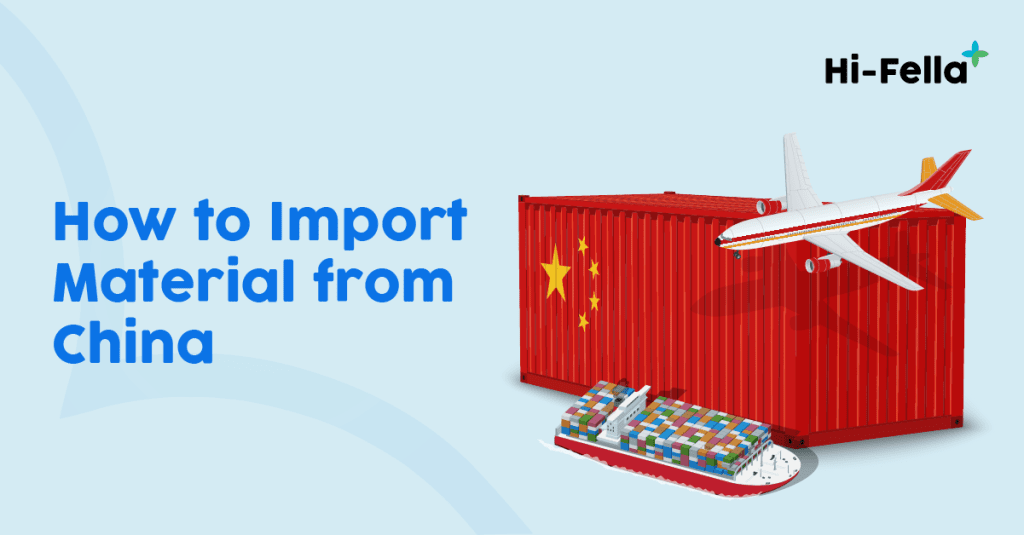China’s vast manufacturing industry offers a wide range of products. Electronics, toys, accessories, almost everything are made in China. Importing goods from China is indeed a great opportunity. However, it can be tricky as well. The first question that arose is how to import material from China? This article will provide you a step-by-step guide to importing from China. Discover the ins and outs of importing materials from China successfully. We’ll give you expert tips for a seamless process.
Step-by-step guide to importing from China
There are 6 steps you can follow on how to import material from China. From selecting the products you want to import to processing your imported goods for your business, we got you covered.
- Select products to import
It is a must to select what product you want to import from China. There are many things to consider when you want to import products from China such as the product would be consistent and sufficient on demand, have at least 30%-50% profit margin, reliable, low maintenance in transit, warehousing, and storing, and has no laws prohibiting that product to be sold in your country. Consider product restrictions, permit and licensing, and import taxes that your country has when it comes to importing goods from China. Some countries might have different regulations regarding importing activity so it is best for you to ask and refer your local government about this issue. - Find Chinese wholesale suppliers
After you decide what you want to import from China, it’s time to find wholesale suppliers. The majority of Chinese suppliers are either trading companies or factories. If you choose trading companies as your supplier, the selection of the product is wide and quality control is great. They also have lower minimum order quantities. But keep in mind that the products from trading companies are usually higher in price and we can’t have control over design and materials they use. If you choose factories as your supplier, they have lower prices and you have more control over the design and material, but usually the choices are not diverse and you need to order it in a certain quantity. You can find suppliers from China from supplier directories and wholesale marketplaces, trade shows, Yiwu Wholesale Marketplace, import records, supplier network - Purchasing
If you already decide which supplier you want to order from, then it’s time to start purchasing. If it is the first time you’re ordering from said supplier, it is best to order with low quantity first to know if the product will suit your business or not. Additionally, it’s crucial to establish mutual understanding with the supplier regarding a product specification document to guarantee you receive your product with exact amount and quality. The document must include shipping terms, payment terms and methods, and product specification. - Arrange transport
There are two types of transport you can choose when importing goods from China: air courier shipping and air and sea freight. Air courier shipping ships your imported goods straight to the final destination. So you don’t have to arrange another shipping to the final destination. DHL, FedEx, and UPS are some of the examples. Whereas air and sea freight ships your imported material from the origin port to the airport or seaport near you. You then need to arrange shipping to your final destination. This can be done by the freight forwarder or freight broker. - Ensure the shipment passes custom clearance
Custom clearance is very important. If you don’t provide the required documentation and follow the procedure, there’s a risk of having your imported goods detained or examined. Or in the worst-case scenario, your imported material would get destroyed or sold at auction. For imported goods that cost less than $800, they don’t require import tax, ‘formal entry’ documentation and process, customs bond, and customs broker, but they do need to be subject to potential holds and examinations. For imported material that cost $800–$2,500, they need to pay import tax and need to be subject to potential holds and examinations, but they don’t need ‘formal entry’ documentation and process, customs bond, and customs broker. For imported goods that cost more than $2,500, they are required to do all of them. - Process the imported goods for the business
If your imported goods are already on your end, you can process it for your business. Create a product catalogue with descriptions and photos, price it accordingly, manage the inventory, and fulfil your order. There are also final and ongoing steps that you need to consider even when the material is already on your end. You need to manage the quality of the product, and if you want to import material from the supplier again, try to negotiate with them regarding price, quantity, packaging, and payment terms. It is also vital to forecast demand, calculate stock, and consider lead times. Consider also having buffer stock so that your stock never runs out dry.
Import regulations and documentation required for importing from China
It is undeniable that when importing goods from other countries, especially China, we need to know the required regulations and documentation in order to keep it well-organized. The documents usually vary by which product you want to import. These are the required regulations and documentation when you want to import goods from China.
- Bill of lading
- Invoice
- Shipping list
- Customs declaration
- Insurance policy
- Sales contract
- Import quota certificate for general commodities (where applicable)
- Import license (where applicable)
- Inspection certificate issued by the General Administration of Quality Supervision, Inspection, and Quarantine (AQSIQ) or its local bureau (where applicable)
- Other safety or quality licenses.
Ready to conquer the business world by importing goods from China? Join Hi-Fella now, an online platform where suppliers and buyers meet. Find your suitable and trusted suppliers from China only by downloading the Hi-Fella app on Play Store or App Store and signing up for an account. Join us now!






